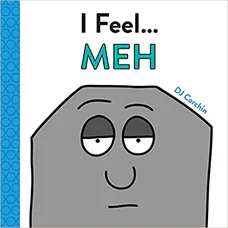I Feel…Meh

Recommended Age Range: Preschool all the way through elementary school.
Publisher's Summary:
Sometimes you just feel…meh. You don’t really feel like doing anything or talking to anyone. You’re not even sure how you’re feeling inside. Is that bad? With fun, witty illustrations and simple, straightforward text, I Feel…Meh tackles apathy—recognizing it as a valid emotion, while also offering practical steps to get you out of your emotional slump. It’s the perfect way for kids—and adults—who are feeling gray to find some joy again!

Dr. Annie's Takeaways
Recommended for: Kids who are struggling with feelings of “meh” (i.e., nothing sounding good), rather than feelings of sadness/guilt/grief will connect with this book. It’s simple and accessible but describes a feeling and path to feeling better that’s quite relevant to anyone who is currently languishing
or feeling blah. It will likely elicit a giggle or two, and it gently suggests an important treatment tool (i.e., behavioral activation
) without being too heavy-handed or at all dark.
Would a child like it? Yes. For a book about an emotion characterized by nothing sounding good, this book is enjoyable and fun.
Evidence-Based Practices:
Behavioral activation
Tone: Light-hearted, a bit silly
Story Quality: In rhyming verse, this book vividly describes the feelings of anhedonia/apathy that often accompany depression (“Sometimes I feel meh. And I don’t want to play. I don’t want to read. And have nothing to say”). It has some silly lines and illustrations in it, which are great for bringing out a laugh from a kid feeling meh, and it is generally both very validating and useful while remaining light-hearted.
Illustrations: Colorful geometric shapes with expressive faces add humor and reinforce the text. The illustrations have an almost emoji-like quality to them.
Representation: The shapes are devoid of any identity markers (i.e., they don’t have clothes or hair or facial features to suggest race or gender).
Psychological Practices: This book nicely describes the feeling of anhedonia (i.e., the inability to feel pleasure) which is often a dominant part of depression for some kids (and adults), and it recommends behavioral activation
–i.e., doing something fun and active anyway. Different ideas are included, such as making plans for a secret lair, flying a kite, making music, and dancing. Behavioral activation is a primary intervention for feelings of “meh.”
Concerns: None
